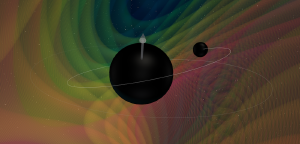Blog
Hostile Takeover
20 April 2020
 N. Fischer, H. Pfeiffer, A. Buonanno (Max Planck Institute for Gravitational Physics), Simulating eXtreme Spacetimes project
N. Fischer, H. Pfeiffer, A. Buonanno (Max Planck Institute for Gravitational Physics), Simulating eXtreme Spacetimes projectWith the LIGO and Virgo gravitational wave observatories, we’ve been detecting black hole mergers fairly regularly. Like the discovery of exoplanets, events are so common now that they are easy to overlook. But sometimes we do find something new and interesting, such as the latest merger known as GW190412.1 What makes this merger unusual is that the two black holes were of very different masses. One was about 8 solar masses, while the other was nearly four times that. This means the merger was quite asymmetric. As a result, the smaller ripples in the gravitational waves (known as harmonics) were amplified in the signal.
Studying these harmonics is crucial to understanding two properties of black hole mergers. The first is to narrow down the distance of mergers. When the two black holes have similar masses, it is difficult to determine whether the strength of the signal is due to their distance or the orientation of their orbits. Since the two black holes of GW190412 have very different masses, that ambiguity goes away.
The second is that the behavior of gravitational wave harmonics allows astronomers to test more subtle predictions of general relativity. With enough data, they should be able to test whether some alternatives to general relativity are more accurate. So far, Einstein’s model still seems to be the most accurate.
GW190412 occurred nearly a year ago, so it has taken time to analyze the data. In the most recent run of LIGO and Virgo, there are more than 50 other candidate mergers that are still being studied. Each of them has the potential to tell us even more about gravitational astronomy, and perhaps further test our theories of gravitational physics.
The LIGO Scientific Collaboration, the Virgo Collaboration. “GW190412: Observation of a Binary-Black-Hole Coalescence with Asymmetric Masses.” arXiv preprint arXiv:2004.08342 (2020). ↩︎